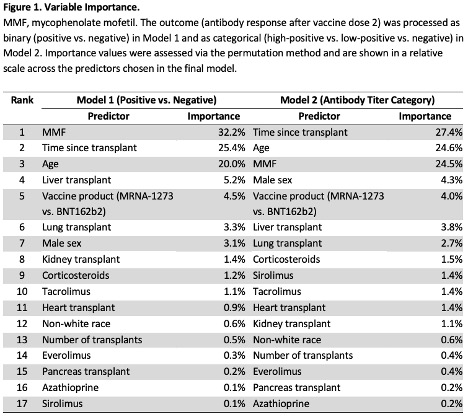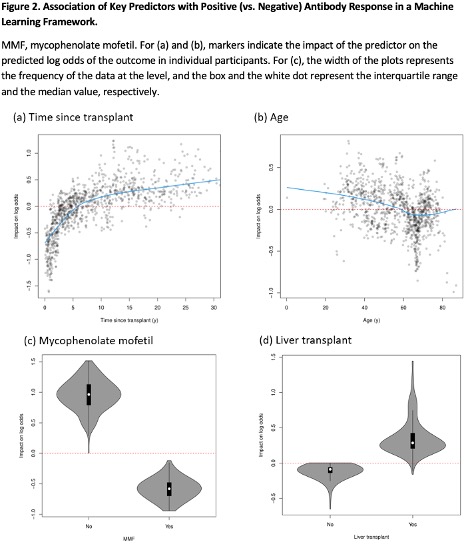A Machine Learning Model for Predicting Antibody Response to 2-Dose Sars-cov-2 MRNA Vaccine Series in Transplant Recipients
J. L. Alejo1, J. Mitchell1, T. Chiang1, A. Abedon1, W. Werbel1, R. Avery1, A. Tobian1, A. Massie1, J. Garonzik-Wang2, D. Segev1, S. Bae1
1JHU, Baltimore, MD, 2U of Wisconsin, Madison, WI
Meeting: 2022 American Transplant Congress
Abstract number: 537
Keywords: Antibodies, COVID-19, Vaccination
Topic: Clinical Science » Organ Inclusive » 72 - Machine Learning, Artificial Intelligence and Social Media in Transplantation
Session Information
Session Name: Machine Learning, Artificial Intelligence and Social Media in Transplantation
Session Type: Rapid Fire Oral Abstract
Date: Tuesday, June 7, 2022
Session Time: 5:30pm-7:00pm
 Presentation Time: 5:50pm-6:00pm
Presentation Time: 5:50pm-6:00pm
Location: Hynes Room 210
*Purpose: Understanding risk factors for impaired vaccine responses can guide strategies for testing, additional dose recommendations, and vaccine schedules to provide improved protection in solid organ transplant recipients (SOTRs). Our purpose was to use machine learning to characterize risk factors and create a prediction model for seroconversion after 2-dose mRNA SARS-CoV-2 vaccination.
*Methods: Using our national observational cohort of 1031 SOTRs we created a machine learning model using gradient boosting to explore, rank, and quantify the association of 19 clinical factors with antibody responses to 2-dose mRNA vaccination. Gradient boosting is a general-purpose machine learning algorithm that generates a sequence of parsimonious prediction models based on the residual error of the previous models. We measured the area under the receiver operating characteristic curve (AUROC) via a 10-fold cross validation to evaluate the model’s performance. Finally, we evaluated the prediction performance of the models in discrimination and calibration with an external cohort of 512 SOTRs from Houston Methodist.
*Results: Mycophenolate mofetil (MMF) use, shorter time since transplant, and older age were the strongest predictors of seronegativity, collectively contributing to 76% of the model’s prediction performance (Figure 1). Other clinical factors, including organ type, vaccine type, sex, race, and other immunosuppression medications, showed weaker associations with seronegativity. Longer time since transplant was associated with higher odds of seropositivity, especially during the first 5 years post-transplant (Figure 2a). Older age among those <65 years old (Figure 2b) and MMF (Figure 2c) were associated with lower odds of seropositivity. The model had moderate prediction performance, with an AUROC of 0.79 (our cohort) and 0.67 (Houston Methodist cohort).
*Conclusions: Our machine learning model allows us to identify SOTRs at highest risk of suboptimal immunogenic response to vaccination, highlighting opportunities for improving protection from COVID-19 including more targeted vaccination strategies.
To cite this abstract in AMA style:
Alejo JL, Mitchell J, Chiang T, Abedon A, Werbel W, Avery R, Tobian A, Massie A, Garonzik-Wang J, Segev D, Bae S. A Machine Learning Model for Predicting Antibody Response to 2-Dose Sars-cov-2 MRNA Vaccine Series in Transplant Recipients [abstract]. Am J Transplant. 2022; 22 (suppl 3). https://atcmeetingabstracts.com/abstract/a-machine-learning-model-for-predicting-antibody-response-to-2-dose-sars-cov-2-mrna-vaccine-series-in-transplant-recipients/. Accessed December 16, 2025.« Back to 2022 American Transplant Congress


